How to grow a date at home from a stone?
Date palm belongs to the Palmov family. There is information that it was grown in Mesopotamia as early as the 6th century BC.
Content:
- Description of the plant
- Planting a date
- Date palm care
- Transplanting a date palm
- Diseases and pests
Description of the plant
The date palm grows naturally in Africa, South America and Arabia. It belongs to feathery palms. It is not very difficult to grow such a tree at home. But it will not be possible to get its fruits.
The dates sold in the store are harvested from common dates. A tree or bush grows 15 m in height, but maybe thirty meters. The size of beautiful feathery leaves reaches 5 m. They are renewed: old ones fall off, new ones grow instead. Gradually, the leaves remain only on the top of the tree, and the straight trunk is covered with longitudinal scars remaining from the fallen leaves.
The date palm blooms in natural conditions with yellow flowers, collected in a panicle inflorescence.
Date palm fruits hang down in whole bunches. At home, in desert oases, his life passes in difficult climatic conditions. To extract moisture from the soil, its thick roots make their way to great depths. At the same time, the water temperature there is quite low. At this time, the top of the palm tree is constantly under the scorching sun rays. These conditions are familiar to the date palm. They provide the active growth and fruiting of the tree.
At home, the Canary date palm and the Robelena palm are usually grown. Of course, its dimensions will be much more modest. After all, it is unlikely that it will be possible to create conditions close to natural ones even in a greenhouse. But even a relatively short palm tree sometimes grows to such a size that it does not fit in the room. Canary palm grows and develops much faster than a tree obtained from a "store" seed.
Planting a date
You can grow a date palm from store-bought seeds. For this, fruits that are not amenable to heat treatment are suitable. Usually they are planted not one, but several, for a guarantee. The seeds removed from the fruit can be immediately placed in the soil without drying or stratifying. You can soak it in warm water for a day. This will remove the remaining pulp from their surface. The water is changed several times.
Landing features:
- It is better to scarify (break) the outer shell, but so that the seed inside is not damaged. This will facilitate and speed up the germination of the germ from the shell. Each of them must be placed in a separate pot. This will help avoid trauma to the roots during transplanting.
- The soil for germination take a special one for palm trees or use vermiculite. You can cook it yourself by mixing peat in equal proportions with ordinary earth or sawdust.
- There must be drainage holes in the pot. But they need to be covered with large stones. If this is not done, the roots will quickly find holes and grow in them. This will complicate the process of replanting the palm tree. After all, its roots are very fragile. The plant can die from damage.
- Moisten the soil and place the date pits in it. Planting depth is equal to one and a half of its length. Install them vertically.
- The optimum temperature for germination is up to 30 ° C. At this temperature, the soil with a high peat content dries out quickly and the sprout dries up.
- Keeps it hydrated at all times. Cover well sphagnum mossthat retains moisture, or cover with glass. The soil should not be wet, only damp.
The seed sprout may not appear soon, the first ones will appear on the surface after about 2 weeks. But sometimes you have to wait six months. Therefore, there is no need to rush to throw out the pot. If the bones germinate in vermiculite all together, you need to take the moment and plant them in a separate bowl.
At first, the vegetation emerging from the point of growth of the palm tree bears little resemblance to the leaves of the palm tree. They are thin and narrow, like shoots. Cats love them, so you need to protect the sprout from the neighborhood with them. Only at the 4th year of the plant's life, the shoots begin to turn into feathery leaves.
Date palm care
Growing Conditions and Care Tips:
- A pot with a palm tree is set in a sunny place. It can be a south or southeast window. Do not allow the earthen coma to completely dry out. From this it can dry out.
- The plant is regularly rotated so that all sides of it are exposed to sunlight. If there is little light on the leaves, they will become brittle. Yes, and they will begin to form more on one side, spoiling the shape of the crown. Each time after the appearance of a leaf arrow, turn the plant so that it is directed towards the room.
- Do not place the date palm pot in a draft. But the room must be well ventilated.
- It is a mistake to think that the date palm requires intense heat for growth and development. The temperature regime for palm trees in summer is 15-20 ° С. In winter it is even lower, the temperature can be lowered to 12 ° C.
- Water the palm tree with soft water. It is better to defend it by waiting until the temperature reaches 18 ° C. It is unacceptable to water the palm tree with chlorinated water. The amount of moisture should be moderate. Do not flood the plant. More water is brought in in spring and summer, less in winter.
- The humidity in the room where the date palm grows should be 50%. Date palm leaves are regularly moistened by spraying water from a sprayer or washing with a soft sponge. Once a week, arrange a shower for the plant, covering the soil with plastic wrap to prevent water from entering. Of course, this only applies to small plants that can be brought into the bathroom.
- If the temperature in the room in summer is below 18 ° C, then the roots of the date palm stop growing, and the plant stops developing. It does not grow even when the soil is too acidic. For normal development, the acidity index should be pH 7.0.
- The date palm is fed weekly with liquid fertilizers in the spring. By autumn, the amount of dressings is reduced. In winter, it is enough to fertilize once a month.
- You cannot form the crown of a tree. The only point of its growth is the top.
Transplanting a date palm
Date palm roots are very fragile. Therefore, it is transplanted by transferring it from a smaller pot to another, the diameter of which is 3-5 cm larger than the previous one. The first time this procedure is performed one and a half months after the emergence of the sprout on the soil surface. You can carefully remove the bone and transplant it along with the sprout into another dish. So that the roots are not injured, it is better to take all the contents of a small pot and transfer it into a new, larger one. The resulting holes near the walls are filled with prepared soil. It can be a mixture of palm trees mixed with vermiculite. You can mix in parts of peat, turf, humus and sand (2 parts), add a handful of charcoal.
A new pot with a transplanted plant is installed in its original place, but the window is covered from direct sunlight during adaptation. Water the soil and spray the ground part of the sprout. The next time is transplanted in another month and a half. The plant should grow approximately 10 cm during this time.The height of the new pot is about 15 cm. A drainage layer is laid at the bottom, this will ensure the outflow of water.
It is necessary to replant the palm annually before it reaches the age of five.
Then it becomes problematic. They start replanting every 3 years, and after reaching 15 years - after 5. Sometimes at this age you can remove the topsoil and replace it with a new one containing nutrients. The roots of the date palm are long, so the pot must be tall. Each time when replanting, the thickness of the drainage layer is increased. More sod land is added to the soil.
Diseases and pests
Consequences of improper care:
- Sometimes brown spots appear on the leaves of the date palm. These are signs of chlorosis. They can be caused by too much watering or using hard water. It is necessary to reduce the amount of moisture received by the plant and filter the water for irrigation.
- A discoloration of the tips of the leaves indicates too dry or cold air, insufficient watering. After evaluating the conditions of detention, one or more parameters of care are changed.
- If all the leaves turned brown and the trunk became soft, then root rotting began. It is urgent to pull the plant out of the pot, shake off the soil and carefully examine the roots. The rotten ones are cut off, the cut site is disinfected with crushed charcoal. New soil is prepared and the plant is transplanted into it. The old soil is thrown away. If there are no living roots, the whole plant is thrown away.
- Palm leaves turn yellow when watering is insufficient. They can go down. White spots appear from direct sunlight burns. In this case, you need to shade the plant.
Sometimes the date palm is affected by pests common to most houseplants. These are spider mites, scale insects and mealybugs. Methods of dealing with them are standard. If it is possible to remove the palm tree from the living space, you can treat it with an insecticide, for example, "Aktellikom" or "Confidor". If not, they are treated with a solution of laundry soap, infusion of garlic and other folk remedies, removing insects from the plant. In this case, you need to cover the soil from the ingress of soapy water. Treatments should be repeated until the pests disappear completely.
Plants adjacent to the palm are also investigated, which can be a breeding ground for pests.
Weakened date palms can be affected by fungal diseases such as leaf spot and pink rot. Treatment is carried out with fungicides containing mancozeb and methyl thiophanate. The interval between treatments is a week.
More information can be found in the video:



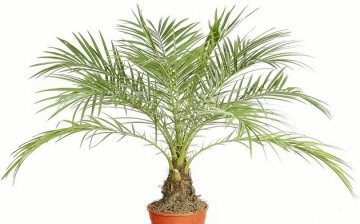
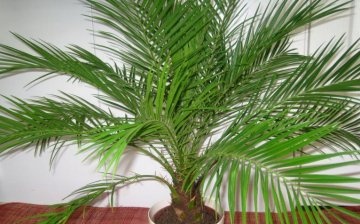
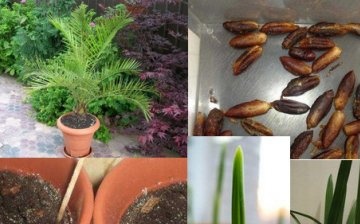
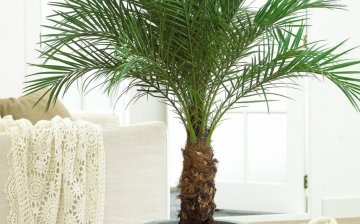
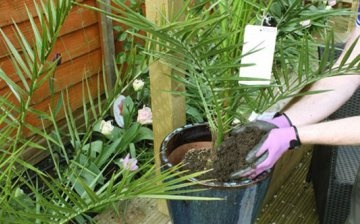







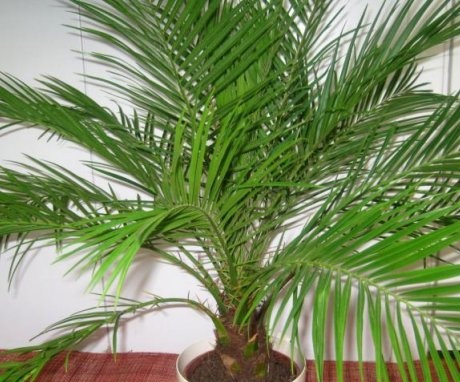
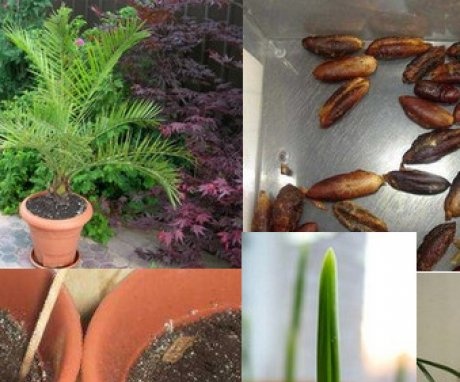

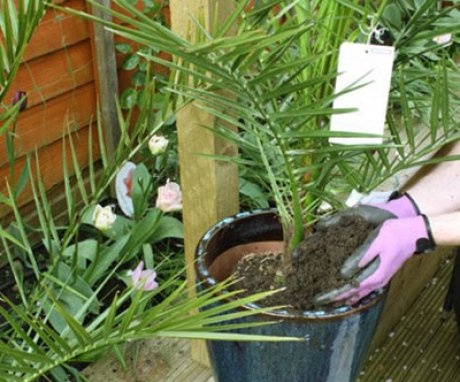

I once planted a date with a bone from a fruit that was bought in the regular market as a delicacy. The plant grew for a long time. Now my palm is about 15 years old, about 1.5 meters tall. Grows in a large pot, about the size of a bucket. But outwardly, my date is different from that in the picture. The variety is probably different.